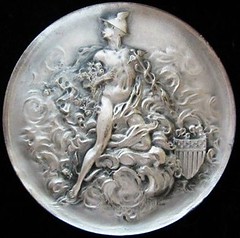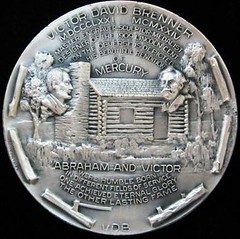
PREV ARTICLE
NEXT ARTICLE
FULL ISSUE
PREV FULL ISSUE
MEDAL SERIES PRODUCER TOIVO JOHNSON


Web site visitor Raymond Gerrity writes: I recently purchased a very large silver medallion designed by Toivo Johnson. The medallion seems to pay tribute to Victor David Brenner. It appears to have been made in 1961 at a place called The Metal Arts Company, Rochester, New York. It has the number 486 on the rim at 12 O Clock. Can you tell me anything about this medal? Where can I find more information about Toivo Johnson & his created works? Does the Metal Arts Company still produce medals?
We did have one earlier E-Sylum item by Dick Johnson - this is how Raymond found us. Here's an excerpt.
-Editor
The issuer was a Maine numismatist, Toivo Johnson (1913-1973) and no relation to the present writer. In 1961 he developed the idea to issue a series of medals to honor coin engravers. His idea was to reproduce the artist's most popular design on one side and a tribute to the artist on the other. He first approached William Louth, president of Medallic Art Company. He came to New York and told Bill of his plan. He wanted Medallic Art to strike the medals. Bill liked the idea of honoring coin designers, but not reproducing the coin design. This was still the era when exact coin images were verboten -- illegal -- and he rejected that concept. He suggested to Toivo to have the artist's portrait on one side and the other a tribute to the artists' numismatic creations. He could have a top artist create the models. Toivo was firm in his mind, that was not what he wanted. The two exchanged words. Toivo left with the rejection ringing in his ears. He would show that Bill Louth what he wanted. So he went to Medallic Art's competitor, Metal Arts in Rochester, New York. Years later Toivo Johnson went back to Metal Arts company and had two more medals made, here again with dies cut by Schabel, the American Freedom Medal and the Maine Sesquicentennial Medal. Both of these were issued in 1970. I forwarded his questions to Dick Johnson, who writes: The series of six medals honoring coin engravers -- five Americas and one ancient -- is a textbook example of what NOT to do. In 1961 Toivo Johnson from Maine came to Medallic Art with an idea for this series of medals. Admirable idea, but flawed concept. He approached company president Bill Louth with his plan. Bill rejected the concept of replicating an existing design by each engraver. Instead he suggested preparing a new model in tribute to the artist. Incensed that his concept was not readily accepted, Toivo left. He rejected Louth's suggestion, steadfast in his own ideas. That same year four numismatists from Ohio came to Medallic Art with a plan for a series of medals. (They wanted to issue medals in similar size to commemorative half dollars recently discontinued by the U.S. Mint.) They wanted to honor U.S. presidents. They listened to the comments of Bill Louth who suggested high-relief medals in the size they wanted. Further he put them in touch with a seasoned sculptor who could create exactly what they envisioned (Ralph Menconi). Louth offered further suggestions in design, metal content, quantity to strike, and marketing. That group of four numismatists became Presidential Art Medals, which became wildly successful. Not only did the presidential series sell well, they went on the create six other series -- for states, signers of the Declaration of Independence, World War II events on their 25th anniversaries, great religions, space explorations, and aviation. All seven series were struck by Medallic Art working closely with the four entrepreneurs. They had listened -- originally and continuously -- to some seasoned medallic advice which served them well. This in contrast to a fixed idea in the mind of Toivo Johnson, who turned instead, to Metal Arts in Rochester to strike his medals. Metal Arts did produce the medals Toivo wanted. But these were not from sculptor's models (but by tracer engraving by a craftsman, not a fine artist). Also, someone chose a quantity to be struck far in excess of what the market could bear. Twenty years later, Toivo's son contacted me. He had inherited a vast quantity of these medals after his father's death. This overhang quantity continues to influence secondary market price, as these remained difficult to sell. I couldn't be of much help in marketing these for him. In contrast, all Presidential Art Medals enjoy a vibrant secondary market appeal and value. Toivo did everything wrong. PS: Metal Arts is still in business, in janitorial services.
To read the earlier E-Sylum article, see:
TOIVO JOHNSON'S COIN DESIGNER MEDAL SERIES
(www.coinbooks.org/esylum_v13n27a15.html)
The Numismatic Bibliomania Society is a non-profit organization promoting numismatic literature. See our web site at coinbooks.org. To submit items for publication in The E-Sylum, write to the Editor at this address: whomren@gmail.com To subscribe go to: https://my.binhost.com/lists/listinfo/esylum All Rights Reserved. NBS Home Page Contact the NBS webmaster 
|